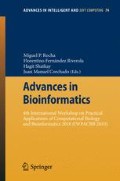Abstract
Being able to predict the human oral bioavailability for a potential new drug is extremely important for the drug discovery process. This problem has been addressed by several prediction tools, with Genetic Programming providing some of the best results ever achieved. In this paper we use the newest state-of-the-art developments of Genetic Programming, in particular the latest bloat control method, to find out exactly how much improvement we can achieve on this problem.We show examples of some actual solutions and discuss their quality from the practitioners’ point of view, comparing them with previously published results. We identify some unexpected behaviors and discuss the way for further improving the practical usage of the Genetic Programming approach.
Access this chapter
Tax calculation will be finalised at checkout
Purchases are for personal use only
Preview
Unable to display preview. Download preview PDF.
References
Archetti, F., Lanzeni, S., Messina, E., Vanneschi, L.: Genetic programming for human oral bioavailability of drugs. In: Cattolico, M. (ed.) Proceedings of GECCO-2006, pp. 255–262 (2006)
Archetti, F., Messina, E., Lanzeni, S., Vanneschi, L.: Genetic programming for computational pharmacokinetics in drug discovery and development. Genetic Programming and Evolvable Machines 8(4), 17–26 (2007)
Kennedy, T.: Managing the drug discovery/development interface. Drug Discovery Today 2, 436–444 (1997)
Kola, I., Landis, J.: Can the pharmaceutical industry reduce attrition rates? Nature Reviews Drug Discovery 3, 711–716 (2004)
Langdon, W.B., Barrett, S.J.: Genetic Programming in data mining for drug discovery. In: Evolutionary computing in data mining, pp. 211–235 (2004)
Poli, R., Langdon, W.B., McPhee, N.F.: A field guide to genetic programming. (With contributions by J. R. Koza) (2008), Published via, http://lulu.com and freely available at, http://www.gp-field-guide.org.uk
Silva, S.: Controlling bloat: individual and population based approaches in genetic programming. PhD thesis, Departamento de Engenharia Informatica, Universidade de Coimbra (2008)
Silva, S., Costa, E.: Dynamic limits for bloat control in genetic programming and a review of past and current bloat theories. Genetic Programming and Evolvable Machines 10(2), 141–179 (2009)
Silva, S., Dignum, S.: Extending operator equalisation: Fitness based self adaptive length distribution for bloat free GP. In: Vanneschi, L., Gustafson, S., Moraglio, A., De Falco, I., Ebner, M. (eds.) EuroGP 2009. LNCS, vol. 5481, pp. 159–170. Springer, Heidelberg (2009)
Silva, S., Vanneschi, L.: Operator Equalisation, Bloat and Overfitting - A Study on Human Oral Bioavailability Prediction. In: Rothlauf, F., et al. (eds.) Proceedings of GECCO-2009, pp. 1115–1122. ACM Press, New York (2009)
Van de Waterbeemd, H., Rose, S.: The Practice of Medicinal Chemistry. In: Wermuth, L.G. (ed.), 2nd edn., pp. 1367–1385. Academic Press, London (2003)
Wishart, S.D., Knox, C., Guo, A.C., Shrivastava, S., Hassanali, M., Stothard, P., Chang, Z., Woolsey, J.: DrugBank: a comprehensive resource for in silico drug discovery and exploration. Nucleic Acids Research 34 (2006), doi:10.1093/nar/gkj067
Yoshida, F., Topliss, J.G.: QSAR model for drug human oral bioavailability. Journal of Medicinal Chemistry 43, 2575–2585 (2000)
Zechman, E.M., Ranjithan, S.R.: Multipopulation Cooperative Coevolutionary Programming (MCCP) to Enhance Design Innovation. In: Beyer, H.G., et al. (eds.) Proceedings of GECCO-2005, pp. 1641–1648. ACM Press, New York (2005)
Author information
Authors and Affiliations
Editor information
Editors and Affiliations
Rights and permissions
Copyright information
© 2010 Springer-Verlag Berlin Heidelberg
About this paper
Cite this paper
Silva, S., Vanneschi, L. (2010). State-of-the-Art Genetic Programming for Predicting Human Oral Bioavailability of Drugs. In: Rocha, M.P., Riverola, F.F., Shatkay, H., Corchado, J.M. (eds) Advances in Bioinformatics. Advances in Intelligent and Soft Computing, vol 74. Springer, Berlin, Heidelberg. https://doi.org/10.1007/978-3-642-13214-8_22
Download citation
DOI: https://doi.org/10.1007/978-3-642-13214-8_22
Publisher Name: Springer, Berlin, Heidelberg
Print ISBN: 978-3-642-13213-1
Online ISBN: 978-3-642-13214-8
eBook Packages: EngineeringEngineering (R0)

